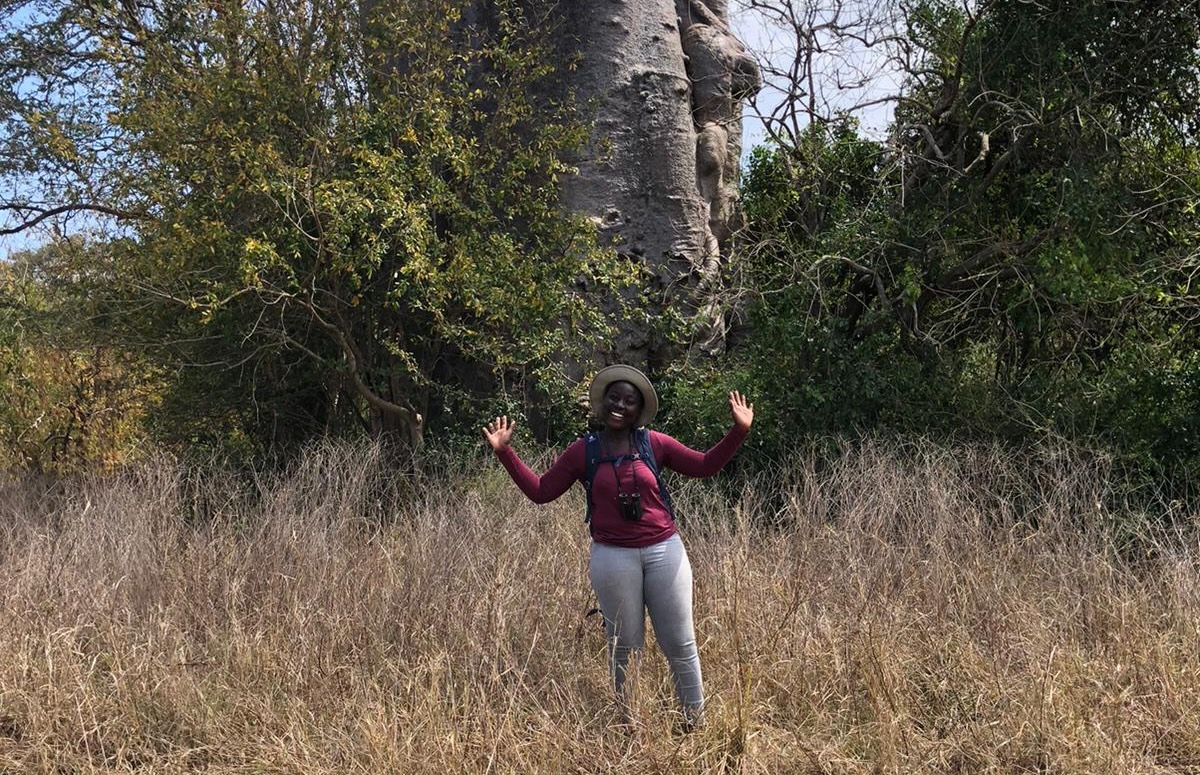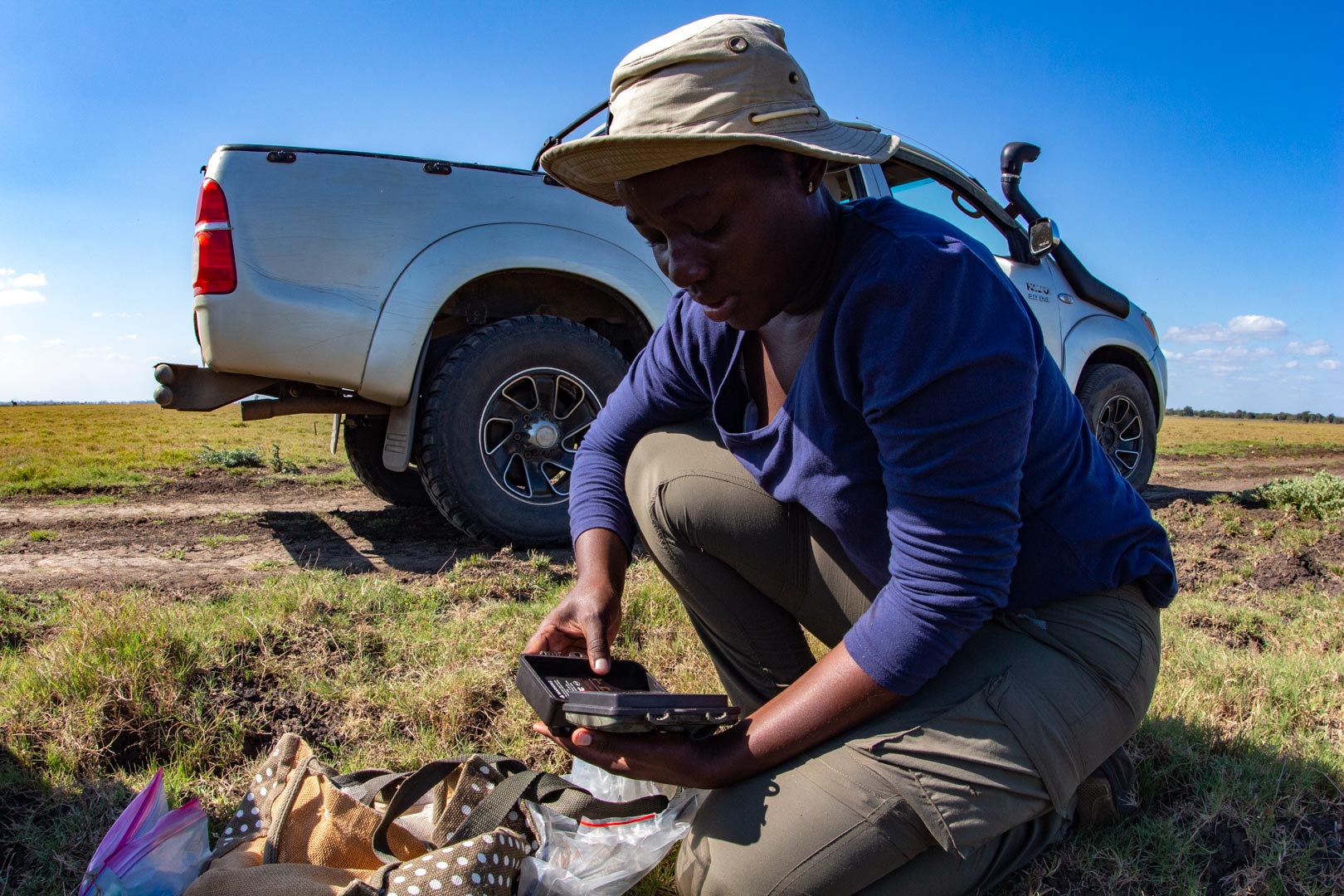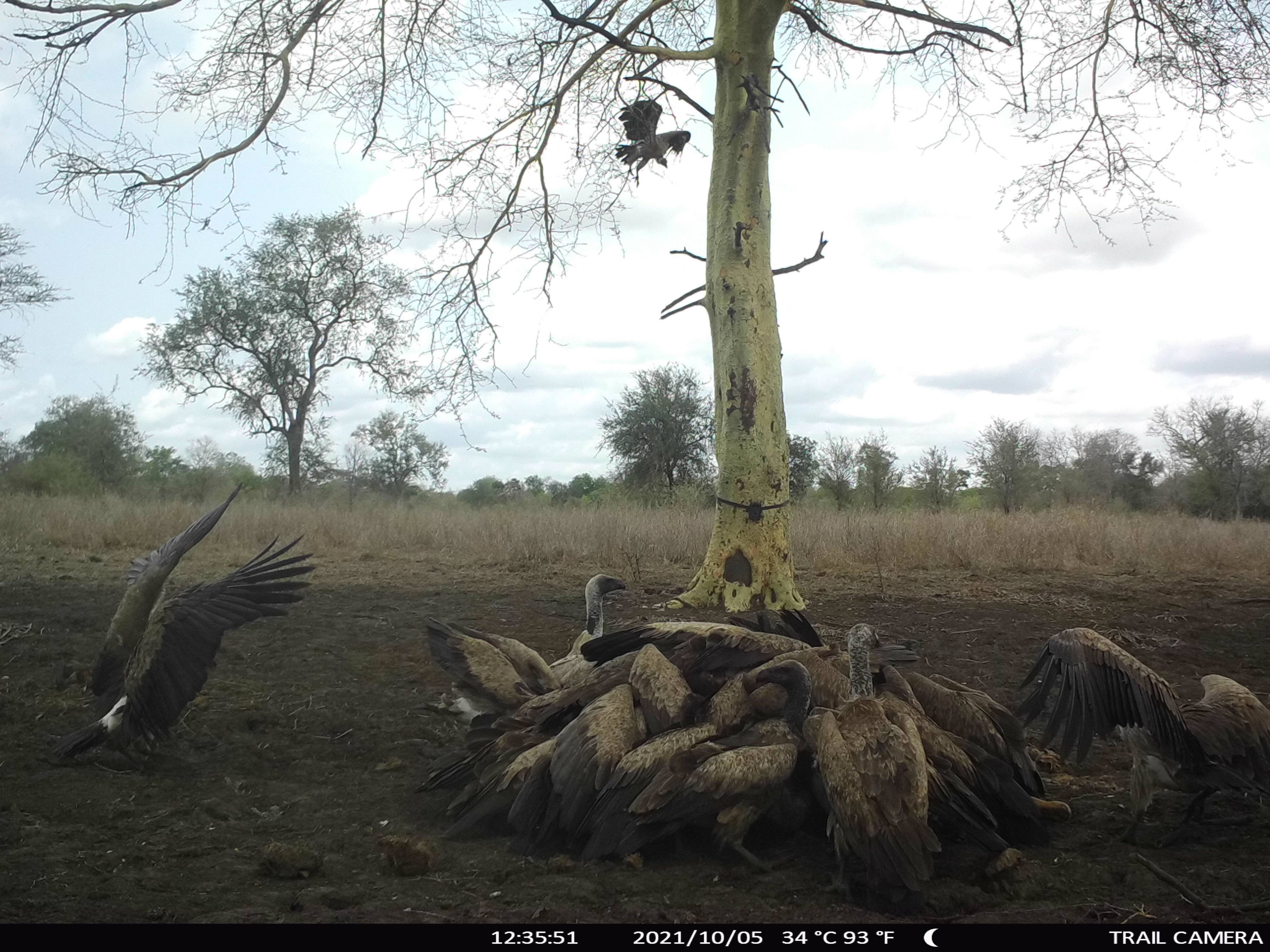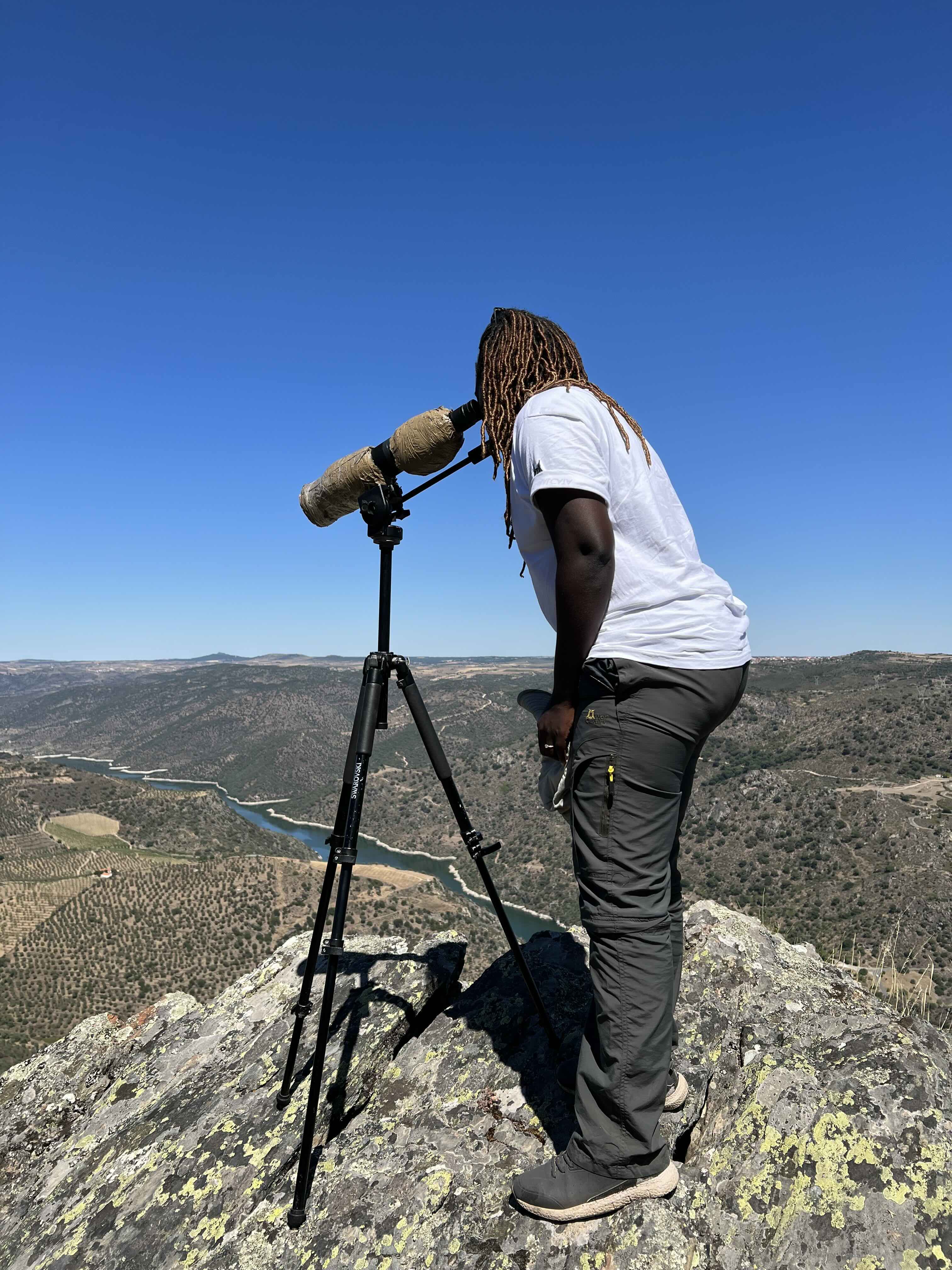
We held a Q&A with Domingas Matlombe to get to know more about her and her work studying vulture behavior at Gorongosa National Park and engaging the Mozambican community in conservation.
Where are you from? Where do you currently work?
I'm from Mozambique. I am currently working on a power line project as an avifauna specialist.
Do you have any ongoing or recently completed research projects?
I recently completed research with vultures in Gorongosa National Park, where healthy populations of white-backed (CR) and white-headed vultures remain. The research combined two aspects: i) ecology - the feeding behavior of vultures, and ii) social dimension – people’s attitudes and perceptions towards vultures.
- Vulture feeding behavior: In this chapter, I studied feeding behavior of four species of African vultures: white-backed vultures (CR), white-headed vultures (CR), hooded vultures (CR) and lappet-faced vultures (EN). To this end, I implemented an experiment with carcasses of domestic goats and impalas, exploring different Gorongosa National Park (PNG) habitats, periods of the day, and climatic conditions. I observed patterns of carcass use by vulture species and age. I studied inter- and intra-specific interactions by observing competitive and aggressive behaviors that occur during the carcass disposal process. I identified the most aggressive species and the submissive species. Based on the success rates for the types of aggression practiced by each species and age class, I established the dominance hierarchy. To capture interaction activities, I used camera traps complemented by direct observations.
- Social dimension: In the second chapter, I studied people's attitudes and perceptions towards vultures. I compared the knowledge of rural and urban communities in relation to vultures, belief systems around vultures, and the sociocultural uses of vultures by people neighboring a protected area (buffer zone communities) and in urban centers close to the park. To this end, I conducted semi-structured interviews with 600 randomly selected people, including: teachers, community and religious leaders, traditional doctors, farmers, livestock breeders, and ordinary people.
Results from the feeding ecology study demonstrate that white-backed and hooded vultures were more aggressive than white-headed and lappet-faced vultures, and adult individuals fed more successfully than juveniles. Vultures are exploited in both urban and rural communities, although rural people had more positive attitudes about and knowledge of vultures than city dwellers. In urban centers, people used vultures as food, while in rural areas vultures were important in traditional medicine and ceremonies, where traditional healers used vulture parts to achieve clairvoyance. In sum, this research provides a deeper understanding of vulture feeding behavior.

Domingas prepares field equipment.
Finish this sentence: I knew I wanted to work in conservation when…
…Mozambique was going through a poaching crisis, between 2010 and 2013. At that time, poachers decimated entire rhino populations. In 2013, the rhino was considered extinct in Mozambique. I remember that at the time, I had never seen a rhino in the wild, and my dream of seeing one was limited because of people who decided to kill rhinos intentionally because of their beliefs (currently rhinos are being reintroduced in Mozambique). Also at that time, more than 3,000 elephants were slaughtered for the illegal ivory trade. According to Mozambican law, killing wild animals and trafficking in rhino horns and elephant tusks were still considered minor crimes. Illegal possession of a weapon was considered a crime in itself. There have been many environmental movements to raise awareness about wildlife, as well as demanding the improvement of environmental laws in Mozambique. I felt like I needed to somehow contribute to protecting wildlife and I've never stopped since. I studied Environmental Education, followed by Conservation Biology. Working in conservation was the best choice I’ve made in my entire life, I can’t imagine doing anything different.
What did you like best about attending ICCB 2023? Was this your first ICCB?
I enjoyed the contributed sessions. I had previously participated in other conferences and congresses, but this component was new to me. I liked it because it is a very interactive space where we can contribute to the topic/research under debate, and the discussion results in tangible products. I had the opportunity to participate in several contributed sessions and in one of them we had the idea of producing an article, which is already in progress. It was my first time participating in the ICCB and I enjoyed it very much.

Domingas's field camera shows vulture swarming an antelope carcass.
Your ICCB Profile says you love working with birds. What is it about birds, particularly vultures, that inspires you?
Vultures are mysterious animals and may be more complex than we know. Spending days in the field observing the vultures - from the moment they find the carcasses to the process of disposing of the carcasses - allowed me to get to know and admire them a little more. I realized that vultures trigger complex networks of relationships between them. Vultures are astute, suspicious, and unpredictable; when we think they are going to do one thing, they do the complete opposite. The mystery in attitudes and looks are things that really enchant me. I also admire their foraging behavior - their keen ability to detect something dead using vision alone (for old world vultures). Old world vultures have no olfactory ability and rely exclusively on vision to find food, it's incredible. Furthermore, vultures are key species in ecosystems. This means that they play a vital role in the structure and functioning of the ecosystem. At the same time, they are the most threatened group of birds in the world due to human attitudes – this is what called my attention to them from the beginning.
You've merged your love for birds and community engagement into a career pathway. Why is community engagement important for conservation, particularly around Gorongosa National Park and Mozambique?
Almost all protected areas in Mozambique have communities living in or around them (which is the case with Gorongosa), and biodiversity is a primary source of sustenance. Many conservation areas were established in a context where people were already there - that is, communities are an integral part of ecosystems in Mozambique. Therefore, community involvement in conservation is fundamental for conservation programs to be effective, as communities have a historical and cultural role in conservation. The Traditional Ecological Knowledge that each community has helps us understand some behaviors or attitudes of the communities, and mainly helps us explain relationships that communities have established with nature.

Domingas in the field.
For your work, what does effective community engagement look like?
Working with birds is challenging, we cannot keep them within the boundaries of protected areas. Birds like vultures, which are my research target group, have an even larger home range. Although vulture populations often occur within protected areas, it is important to consider areas beyond the boundaries of protected areas, as they can represent a significant portion of vulture home ranges. Therefore, it is suggested that the protection of vultures should be extensive, that is, at the landscape level. But, to make this action effective, we depend on the support of local communities. They can support by providing information such as which species appear most in their community, saying when and where they saw them, and especially not killing the birds and not destroying the nests of any birds. Thanks to the support of the communities, I’ve located two colonies of birds, outside the park's boundaries, that forage in chicken production factories, in an urban area close to the park. We know that some vultures leave the park because some were marked and placed with satellite transmitters, for a master's research.
What is the most interesting thing you've learned from your engagement with local communities that you can or will apply to your work?
There are many lessons that can be learned from interactions with communities. Every trip, every activity, and every interaction with a community, I never come back the same person. I feel privileged to be able to see the world from a different perspective than the modern world we are used to. When we work with communities, we must strip away who we are. Leave aside academic titles, noble surnames, and financial conditions. We must sit on the floor together with the community, walk barefoot, eat with our hands, and be transparent – this certainly applies a lot to my day-to-day life. Before attempting any type of contact, we must have a basic understanding of the group with whom we are going to interact. I'm talking about their culture, beliefs, habits, and customs, so that we in no way offend the target group. Respect the process and be very patient, as everything takes time. When we do things, we expect immediate results. When it doesn't happen we get frustrated, we feel incapacitated, and sometimes we feel as if we are wasting our time. Working with communities is like planting a tree, through a seed. You need to be patient and respect the time it takes for the plant to develop until it bears fruit. We can be there, caring for and monitoring the development that can be very slow due to several factors. We must be patient. Finally, unity is strength. We need each other.

Domingas in the field.
Gorongosa National Park takes a comprehensive approach in its work to restore the park. This includes work in community engagement, community health, and education, particularly the education of girls. How has this approach contributed to the restoration of Gorongosa National Park and better livelihoods for communities around the park?
The Gorongosa Restoration Project is one of the most complex conservation efforts in Mozambique, and perhaps Africa. It serves as an example of how human development and ecological restoration work together, so there is some hope that both will succeed. Mozambique's civil war reduced more than 90% of the wildlife density in PNG. In addition to the natural recovery of the remaining populations, one of PNG's restoration strategies is the engagement of local communities, mainly focusing on education aimed at human development and well-being. PNG understands that the development of the park must be accompanied by the development of the community. Community development is possible through education, because through education we can shape the future. Through community programs, the park, in addition to offering employment, creates alternative sources of income for communities to improve their income and well-being. At the same time, communities are taught the principles and values of conservation, so that they understand the purposes of the park and are able to support it. This program offers hope for a better life, where people do not need to commit crimes, such as illegal hunting, to live. The park offers opportunities to dream. Girls are an alien group of the park because, in African culture, rural women are born with a defined destiny to marry and have children - they are not allowed to dream much. Through the girls' education program, women are able to dream of a better future, in which they are the ones to choose their partners, in which they are the ones to decide when and how many children to have. Through the girls' education program, women for the first time feel heard and their opinions are welcomed. Furthermore, it is women who deal with resources, such as land and water, to take care of their families, and it is believed that women are more sensitive to environmental issues. They are the ones who spend more time caring for and educating children (who are the hope of tomorrow). By empowering women, the park is enhancing their knowledge and experience so that it benefits everyone. Through these programs, women are already occupying leadership positions in natural resource management committees and supporting the development of their communities. The communities are seeing positive changes in their lifestyle. They are aware that such change comes from tourism that is carried out in the park, and that tourism is only possible if we continue to conserve biodiversity. Today, communities look at the park with a sense of belonging, and feel a duty to conserve what is also theirs. If previously some elephants and other animals were killed when entering communities and feeding on their farms, today the opposite is happening. It is the communities that alert the park when the animals leave and they are the ones who support the animals to return to the park, using mechanisms that are taught by the park. Through this approach, the park has the full support of communities, as watchdogs and mainly as conservation agents.
What are your aspirations for the future of conservation in Mozambique and Africa more broadly?
In Mozambique and Africa, I would like conservation to be considered a priority, and not something that should be on the agenda as a requirement or as a mechanism to raise funds for unclear purposes. I would like to see laws work and be applied to everyone. I would like to see young people, adults, leaders, men, and women understand the importance of the environment and engaging with the cause. I would like to see Mozambicans become more aware that everyone has a role in conserving the environment. I would like conservation to be a lifestyle in Mozambique, Africa, and the world.